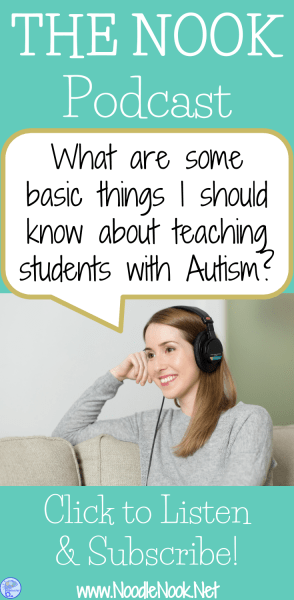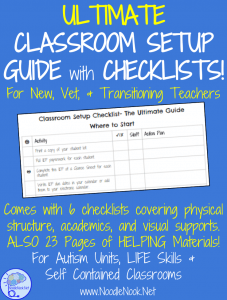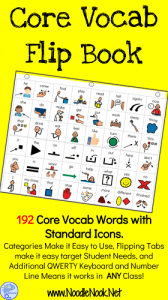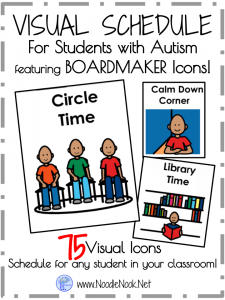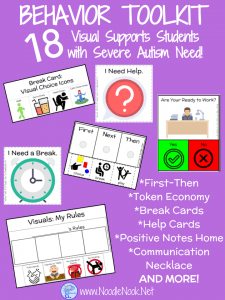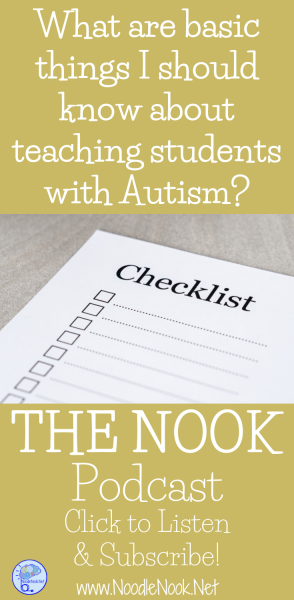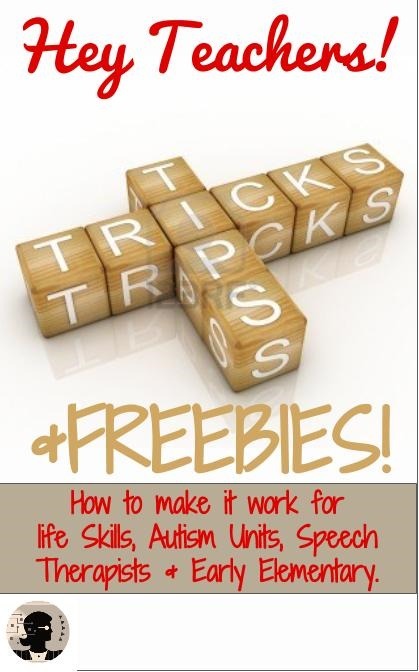Episode 2 of The Nook Podcast
On this episode, we answer Rebecca’s question on basics she needs to know in her Autism classroom. Listen here and be sure to subscribe!
SHOW NOTES
Hey y’all, it’s Ayo here with NoodleNook.Net and welcome to Episode 2 of The Nook!
Thank you so much for joining me today. As always I’m here to help you with your questions about teaching students with severe and profound disabilities including Autism. And today we have a great question from Rebecca, but before we get to her pressing question I want to let you know that you can have your questions answered here on the podcast by submitting them on the NoodleNook.Net website. You can do that by going to www.NoodleNook.Net/podcast and if your question is chosen you will get a free resource from The Noodle Nook store where you can choose from some of the new vocational work tasks designed for multi-leveled classrooms including more challenging tasks for students who are beyond the basics or maybe one of the social stories to work on social skills. With so many choices there will surely be something that works for you and your students, so get over to the Noodle Nook.Net/podcast site and submit your questions today!
What are some basic things I should know about teaching students with Autism?
All right, so here’s today’s question from Rebecca. What are some basic things I should know about teaching students with Autism? Rebecca, that’s a great question and it’s a problem that I see over and over again. So many teachers get through their new teacher training or come through alternative certification and still have a lot of questions about how to set up their classrooms for success. Here are a few basic things you should know when teaching students with Autism.
Number One is that you want to make sure that you have structure in your classroom. And by structure that means a predictable routine that goes on every day. For me, it was always making sure that although there was a lot of variety in a given week, every week was just like the one previous. So every Monday during third period, we always did the same thing. What that really allowed in the classroom was that students always knew what to anticipate and the staff always knew what to do to get the class going and support students. So that predictability and routine & procedure is going to be really important as you try to establish structure within your classroom.
The second thing I would do to support structure is to make sure you have some sort of visual schedule in your classroom and that can be written or in pictures. Either or, but something that you can refer to, that your students can refer to, and that your support staff can also look to so everyone always knows what’s coming next.
The Second thing I would say you would want to make sure you have in your classroom is some sort of consistent communication system for all of your students. Every student in your classroom should have choice and voice, so some kind of way that they can communicate and some way to make choices throughout the day. Now this communication system can be with visuals, can be with a VOD or assistive technology, high-tech low-tech, that’s really up to the student. But as you’re going through the day I want you to really ask yourself if every single student you work with can communicate with you.
You may also want to address communication with social languages as well. Sometimes it’s one thing to be able to answer yes or no to the teacher when were asking comprehension questions, but quite another to be able to talk to peers in a social way. You want to make sure that both of those options are available.
The third thing I would say you want to make sure you have when you set up your classroom is to have Independence built-in. Now we’ve got a couple of blog post that talk about learned helplessness and prompt dependence on the NoodleNook website, and I suggest you go back and read those. We want to make sure that we are addressing building of independence for our students. I give this example of getting a pencil.
I worked with a student for a while and everyday we asked him to get a pencil, and every day he did not get one. But inevitably one of my support staff would get it for him. I realized that if that happened for me in my daily life I’d probably stop trying too. If I knew that if I waited long enough my husband was going to do the dishes, I’d never lift a finger to go towards that sink. And that’s kind of what the student had learned. If he sat there, eventually the pencil would show up. So when your building that independence, really start to think about how dependent your students are on prompts, how much support you offer your students who have the capacity to do skills, and also if you’re really addressing functional skills in a way that is meaningful to the students. And when I say that, it means that if you’re asking a student to tie their shoe, they have the skill set to do so. If they don’t, how many steps can they get through before you help them? We want to make sure that our students are still trying with those functional skills to be more Independence, even if they don’t have a complete set of skills.
[tweetthis]Great Podcast for Educators on Teaching kids with Autism! [/tweetthis]
So number four would be to address specific behaviors. Every student that comes into your self-contained classroom is going to have a different set of behaviors that need to be addressed. Some of those may be aggressive or attention seeking behaviors, but no matter the needs of your student you want to make sure you’re identifying a replacement behavior and teaching the students the skills they need to be successful. Make sure you know what replacement behavior really means. It doesn’t mean that you have a way to punish your students when they are not doing the right thing, it’s the skills that you’re going to teach your students so they learn how to do the right thing. So pop on over to the Replacement Behavior post on this site and read through the article.
So we’ve got some solutions for you already that was 1. Structure, 2. A Communication System, 3. Building Independence, and 4. Addressing Specific Behaviors. Number 5 is to improve on Social Skills. And I tell you this because social skills are so important for students, especially in self-contained where there are fewer opportunities to socialize with non-disabled peers. So we always want to be working on social narratives and social scripts to help our students know what to do and what to say when they are out in the community, when they are out of the school community, and when they are interacting with peers.
All right Rebecca, that’s 5 things you can do in your classroom to be more successful as you teach students with Autism. The last thing I wanted to say is to be sure not to underestimate a child with Autism. Their success or failure is largely due to you, your expectations, and how you differentiate activities as opposed to the students perceived limitations. Remember, Autism is not an intellectual disability, it’s a sensory processing deficit that impacts communication. So really think about how your students are able to access and manipulate the academics and communicate with you and their peers.
Thank you so much for your question Rebecca. I’m going to send you out a product of your choice from The NoodleNook store. I also want to send you out the Visual Schedule Featuring Boardmaker for your classroom from the NoodleNook Store so that you can have a visual schedule to post in your classroom. Good luck, and for those of you listening, if you want to have your question answered here on The Nook, head over to www.NoodleNook.Net and click on the podcast button to submit your question.
I also want to mention one more solution to a common problem in Autism units, and that’s having effective visuals to work on communication and behaviors. The Behavior Toolkit in the NoodleNook store has visuals like “I need a break, first-then visuals, and rule cards so you can start establishing those expectations with your students early. With good visuals and place you can see it change and your students performance and behavior, so check it out in the NoodleNook store today at www.noodlenook.net/tpt-store!
With so many questions out there on how to be the best teacher as you work with students with severe disabilities and low incidence in disabilities lot, like Autism, be sure you’re subscribing to the blog so you can get tips, tricks, and freebies! We need all the great teachers we can get, so say stay strong and teach on!
Thanks for listening to The Nook. Don’t miss the next episode, subscribe today!
Article Citation: [cite]

